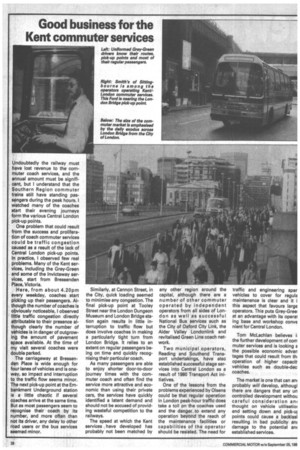Good business for the Kent commuter services
Page 24

If you've noticed an error in this article please click here to report it so we can fix it.
Undoubtedly the railway must have lost revenue to the commuter coach services, and the annual amount must be significant, but I understand that the Southern Region commuter trains still have standing passengers during the peak hours. I watched many of the coaches start their evening journeys form the various Central London pick-up points.
One problem that could result from the success and proliferation of coach commuter services could be traffic congestion caused as a result of the lack of Central London pick-up points. In practice, I observed few real problems. Many of the Kent services, including the Grey-Green and some of the Invictaway services, start from Bressenden Place, Victoria.
Here, from about 4,20pm every weekday, coaches start picking up their passengers. Although the number of coaches is obviously noticeable, I observed little traffic congestion directly attributable to their presence although clearly the number of vehicles is in danger of outgrowing the amount of pavement space available. At the time of my visit several coaches were double parked.
The carriageway at Bressenden Place is wide enough for four lanes of vehicles and is oneway, so impact and interruption to the traffic flow seems minor. The next pick-up point at the Embankment Underground station is a little chaotic if several coaches arrive at the same time. But as most passengers seem to recognise their coach by its number, and more often than not its driver, any delay to other road users or the bus services seemed minor.
Similarly, at Cannon Street, in the City, quick loading seemed to minimise any congestion. The final pick-up point at Tooley Street near the London Dungeon Museum and London Bridge station again results in little interruption to traffic flow but does involve coaches in making a particularly tight turn from London Bridge. It relies to an extent on regular passengers being on time and quickly recognising their particular coach.
As many passengers are able to enjoy shorter door-to-door journey times with the commuter coach and often find the service more attractive and economic than using their private cars, the services have quickly identified a latent demand and should not be accused of providing wasteful competition to the railways.
The speed at which the Kent services have developed has probably not been matched by any other region around the capital, although there are a number of other commuter operated by independent operators from all sides of London as well as successful National Bus services such as the City of Oxford City Link, the Alder Valley Londonlink and revitalised Green Line coach network.
Two municipal operators, Reading and Southend Transport undertakings, have also established successful stage services into Central London as a result of 1980 Transport Act initiatives.
One of the lessons from the problems experienced by Olsens could be that regular operation in London peak-hour traffic does take a toll on the coaches used and the danger to extend any operation beyond the reach of the maintenance facilities or capabilities of the operator should be resisted. The need for
traffic and engineering spar vehicles to cover for regula maintenance is clear and it i this aspect that favours large operators. This puts Grey-Greel at an advantage with its operal ing base and workshop conve nient for Central London.
Tom McLachlan believes ii the further development of com muter services and is looking a the possible economic advan tages that could result from thi operation of higher capacit vehicles such as double-dec coaches.
The market is one that can an probably will develop, althougl there are dangers that any un controlled development withou careful consideration am thought on vehicle utilisatioi and setting down and pick-ul points could cause a backlasl resulting in bad publicity an damage to the potential an( established services.












































